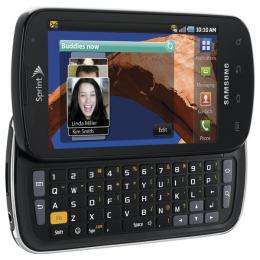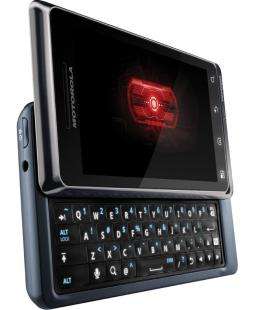A look at new Android cell phones

Google's Android operating system has come a long way in the past year.
A year ago, you had two choices if you wanted an Android smart phone, and both were offered only by T-Mobile. Since then, the Android ecosystem has exploded with options. Every major U.S. carrier now offers Android phones, and they come with a variety of features and in various shapes, sizes and prices.
I've been testing some of the latest -- Samsung's Epic 4G, Motorola's Droid 2 and Motorola's Charm. All share the same basic Android OS and some core features, but each is likely to appeal to different audiences.
The Epic 4G, one of Samsung's recently debuted Galaxy line of smart phones, is the new star of Sprint's Android lineup. It sports a slide-out keyboard, a speedy processor, and a much more pocketable design than the jumbo-size HTC Evo 4G that formerly topped the list of Sprint Android phones. It also comes with a 16-gigabyte flash memory card, which is a good amount of storage compared with other Android devices.
But the big selling point of the Epic 4G is its "super" OLED (organic light-emitting diode) screen. A new type of display technology, OLED screens tend to produce deeper blacks and a wider range of contrast between lights and darks than the LCD displays used in most TVs and phones.
The Epic 4G's screen is able to display a beautiful range of colors and multiple levels of brightness. Pictures and videos look good but not great; the screen is not nearly as high-resolution as Apple's iPhone 4, so it can't display high-definition videos. And for some reason, whites -- such as the background of a Web page -- can look dim even with the screen's brightness turned all the way up.
Another selling point for the Epic is its keyboard. While many of the first Android phones included physical keyboards, more recent ones have largely abandoned them for virtual ones accessed by tapping on their touch screens.
I generally prefer virtual keyboards because I can type faster and because keyboards add extra weight and size to a phone. But I liked the Epic's keyboard. It's well laid out, with dedicated number keys, adequate space between the buttons and, in a nice touch, a system buttons such as "home" and "menu." These duplicate the functions of the touch-sensitive system buttons on the phone's face, but those buttons can be hard to press when you have the phone turned on its side to use the keyboard.
I was less impressed with other aspects of the Epic. Its rounded, thick shape is somewhat uncomfortable in the hand and hearkens back to the smart phones made before the sleek iPhone debuted three years ago.
A much bigger problem, though, is that it's linked to Sprint, whose coverage can be spotty compared with other carriers. I wasn't able to get a steady signal at my desk, for example. And when driving in south San Jose, I was able to get a signal only by roaming on another company's network, which can incur extra fees. Even then I was unable to use the Epic's GPS to navigate back to the office.
The Droid 2 is Motorola's answer to Samsung's Galaxy phones. It's an update of the original Droid, the first hit Android phone, and has basically the same rectangular case. But it sports many of the same updated features as the Epic, including a 5-megapixel camera and a 1-gigahertz processor.
The Droid 2 has some significant advantages over the Epic. The biggest is that it is on Verizon's network, which has the best coverage of any major carrier.

Also, unlike the Epic, the Droid 2 comes with the latest iteration of Android -- version 2.2 -- preinstalled. It includes Adobe's new mobile Flash player, which allows users to watch videos, play games and view websites that they wouldn't otherwise be able to access. The Epic is likely to get the latest version of Flash soon, but users will have to download and install it.
Additionally, the Droid 2 felt better in my hand. It's thinner and narrower than the Epic, making it easier to hold.
Still, the Droid 2 is not a clear winner when compared with the Epic. Its screen has a similar resolution, but images seem washed out by comparison. And despite a comparable processor, the Droid 2 felt sluggish at times, slower than expected at changing screens or pulling up applications. Also, the keyboard felt cramped, with small buttons and no dedicated number keys.
The Droid 2 is merely one of many Motorola Android phones; the company is producing a full line with a range of options and designs. Another recent effort is the Charm, which is more of a messaging phone or entry-level smart phone than a full-featured one. It's priced accordingly; T-Mobile is selling the Charm for about $50 with a two-year contract.
The Charm is squarish in shape, with a keyboard on its face, much like a BlackBerry from early last decade. It's thin and light, making it easy to fit in a pocket and carry around. The Charm runs Android 2.1 and includes the latest version of Motoblur, Motorola's software that aims to bring all of your messaging and social networking updates into one widget.

But in many ways, users will get what they pay for. The Charm's screen is small -- about half the size of the Epic's -- and low-resolution, making photos and graphics look pixelated. The keyboard, which takes up about a third of the Charm's face, is cramped, with tiny keys that can be hard to press. And T-Mobile tends to have even worse coverage than Sprint.
None of the three new phones, then, is a home run. But they each add to the Android options and, for many consumers, will definitely be worth a look.
_____
TROY'S RATING:
Samsung Epic 4G:
• 4.0 out of 5
• Likes: Eye-catching screen, spacious keyboard, slick interface
• Dislikes: Spotty network, older version of Android OS, relatively wide and fat case
• How much: $249.99 with a two-year Sprint contract
• Web: www.sprint.com or www.samsung.com
Motorola Droid 2:
• 3.8 out of 5
• Likes: Good network coverage, latest version of Android with Flash, relatively slim case
• Dislikes: Cramped keyboard, sluggish performance
• How much: $199.99 with a two-year Verizon contract
• Web: www.verizonwireless.com or www.motorola.com
Motorola Charm:
• 3.0 out of 5
• Likes: Thin and light, Motoblur software centralizes messages and social networking updates
• Dislikes: Cramped keyboard, low-resolution screen
• How much: $49.99 with a two-year T-Mobile contract
• Web: www.t-mobile.com or www.motorola.com
(c) 2010, San Jose Mercury News (San Jose, Calif.).
Distributed by McClatchy-Tribune Information Services.




















